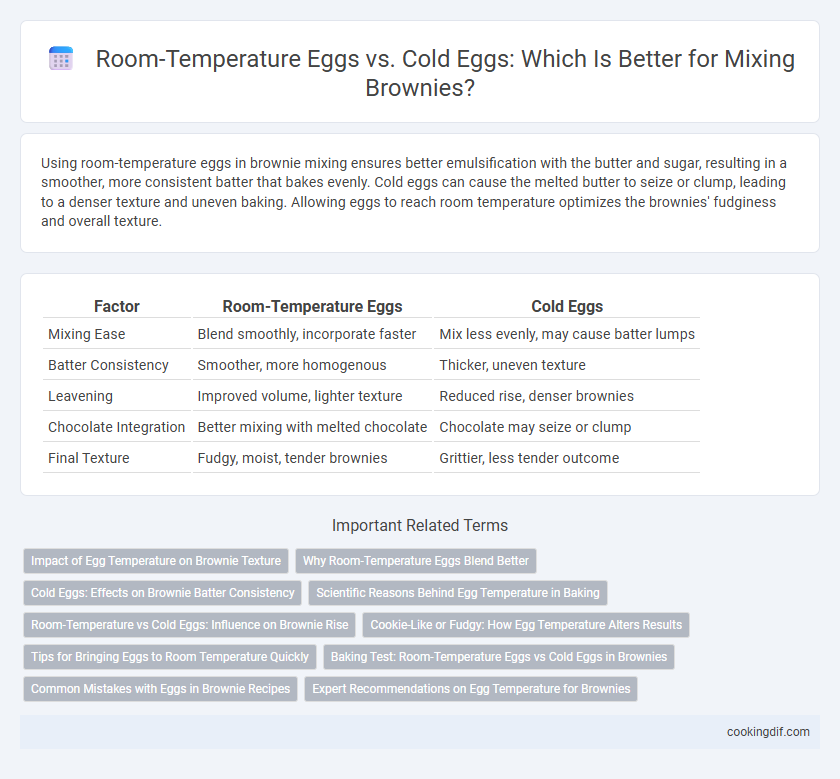Using room-temperature eggs in brownie mixing ensures better emulsification with the butter and sugar, resulting in a smoother, more consistent batter that bakes evenly. Cold eggs can cause the melted butter to seize or clump, leading to a denser texture and uneven baking. Allowing eggs to reach room temperature optimizes the brownies' fudginess and overall texture.
Table of Comparison
| Factor | Room-Temperature Eggs | Cold Eggs |
|---|---|---|
| Mixing Ease | Blend smoothly, incorporate faster | Mix less evenly, may cause batter lumps |
| Batter Consistency | Smoother, more homogenous | Thicker, uneven texture |
| Leavening | Improved volume, lighter texture | Reduced rise, denser brownies |
| Chocolate Integration | Better mixing with melted chocolate | Chocolate may seize or clump |
| Final Texture | Fudgy, moist, tender brownies | Grittier, less tender outcome |
Impact of Egg Temperature on Brownie Texture
Using room-temperature eggs in brownie mixing promotes better emulsification of fats and sugars, resulting in a smoother batter and improved texture. Cold eggs can cause uneven mixing, leading to denser brownies with less tender crumb structure. Optimal egg temperature enhances moisture distribution and contributes to a fudgier, more consistent brownie texture.
Why Room-Temperature Eggs Blend Better
Room-temperature eggs blend better in brownie mixing because their proteins and fats emulsify more effectively, creating a smoother batter with consistent texture. Cold eggs can cause fats like butter to solidify, resulting in uneven mixing and less tender brownies. Maintaining eggs at room temperature helps achieve optimal moisture distribution and enhances the overall rise and crumb structure of the final baked brownie.
Cold Eggs: Effects on Brownie Batter Consistency
Cold eggs can cause brownie batter to become denser and less smooth due to their lower temperature inhibiting proper fat emulsification. This results in a batter with uneven texture and may affect the final crumb of the brownies, making them less tender. Using cold eggs can slow down the blending process, leading to less aerated and heavier brownie batter.
Scientific Reasons Behind Egg Temperature in Baking
Room-temperature eggs blend more evenly with butter and sugar, creating a smoother batter due to reduced viscosity and improved emulsification. Cold eggs can cause butter to solidify, resulting in uneven texture and less rise in brownies. Scientific studies show that warmer eggs promote better air incorporation, leading to improved leavening and a tender crumb.
Room-Temperature vs Cold Eggs: Influence on Brownie Rise
Room-temperature eggs improve brownie rise by incorporating air more easily during mixing, resulting in a lighter texture and better volume. Cold eggs, being denser, mix less effectively with the batter, potentially leading to a denser and less risen brownie. Optimal brownie rise is achieved when eggs are brought to room temperature before mixing.
Cookie-Like or Fudgy: How Egg Temperature Alters Results
Using room-temperature eggs in brownie batter promotes better emulsification, resulting in a fudgy, moist texture due to enhanced fat and sugar integration. Cold eggs can cool the batter, causing uneven mixing and a more cookie-like crumb with less moisture retention. Optimal brownie texture depends on balancing egg temperature to influence gluten development and fat crystallization.
Tips for Bringing Eggs to Room Temperature Quickly
To bring cold eggs to room temperature quickly for brownie mixing, place them in a bowl of warm (not hot) water for about 5-10 minutes. This method ensures the eggs blend smoothly with other ingredients, enhancing batter consistency and baking results. Avoid using hot water to prevent partial cooking or texture issues in the brownie batter.
Baking Test: Room-Temperature Eggs vs Cold Eggs in Brownies
Baking tests comparing room-temperature eggs and cold eggs in brownie mixing reveal that using room-temperature eggs improves batter emulsification, resulting in a smoother texture and enhanced rise. Cold eggs can cause the butter to seize, leading to denser brownies with uneven crumb structure. Optimal brownie recipes recommend eggs at 70degF (21degC) for ideal moisture retention and consistent baking performance.
Common Mistakes with Eggs in Brownie Recipes
Using cold eggs straight from the refrigerator often leads to uneven batter and dense brownies due to poor ingredient integration. Room-temperature eggs blend more smoothly with butter and sugar, ensuring a consistent texture and proper rise. A common mistake is skipping the step of warming eggs, which can cause curdling or separation when combined with melted ingredients.
Expert Recommendations on Egg Temperature for Brownies
Expert bakers emphasize using room-temperature eggs for brownie mixing as they blend more uniformly with butter and sugar, ensuring a smoother batter texture. Cold eggs can cause the butter to seize or clump, hindering the incorporation process and potentially resulting in dense brownies. Maintaining eggs at around 68-72degF aligns with optimal emulsification, enhancing the final brownie's moistness and crumb structure.
Room-temperature eggs vs cold eggs for brownie mixing Infographic

 cookingdif.com
cookingdif.com